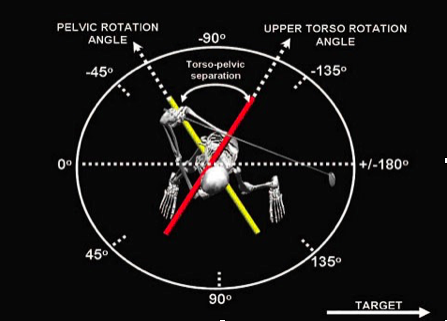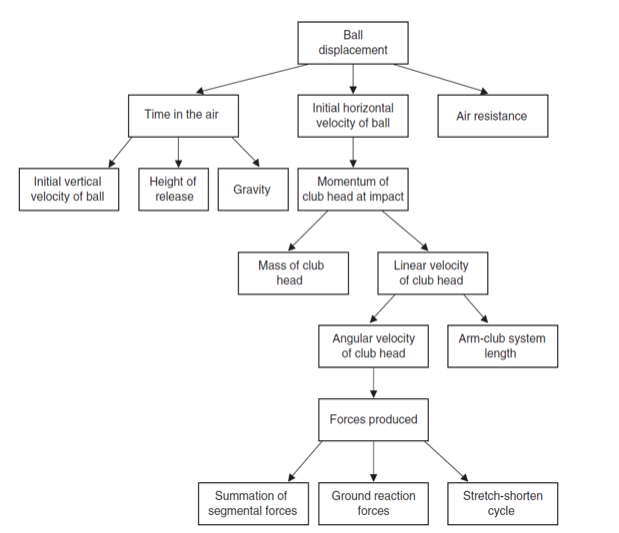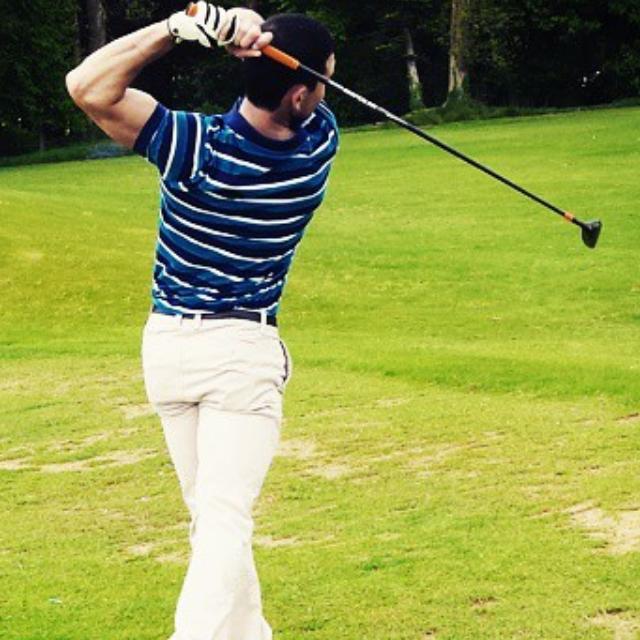IMPROVE MY GAME
Articles
X-Factor Essentials: What it is and How to Train it
Introduction:
Sport science has become an integral element of elite golf preparation in recent times. Clubs, balls, shoes, video analysis, and strength and conditioning programs have all become common place. This article aims to concentrate on what is termed the “X-factor” in the golf swing, the relationship between the X-factor and ball striking performance, and strength & conditioning training interventions seeking to improve power in the golf swing. It is hoped that this will serve as a resource that can assist coaches and players identify potential elements of the golf swing to focus on and possible strength and conditioning interventions that may be more effective than those currently popular.
The term X-factor is used to describe the rotation of the shoulders in relation to the hips throughout the swing (Cheetham et al 2011; Sweeney et al 2011). The X-factor enhances the power of the golf swing by means of utilising the stretch shortening cycle (SSC). The SSC is the rapid change from an eccentric to concentric muscular contraction. This rapid eccentric stretch of a muscle before it is concentrically contracted produces a more powerful contraction than if a muscle was contracted purely concentrically, most likely due to stored elastic energy in the muscles and tendons involved in the action (Flanagan and Comyns 2008; Hume at al 2005). Modern golf swings are excellent examples of a powerful SSC motion. During the backswing the hip, trunk/torso, and shoulder muscles are quickly stretched, loading them with elastic energy, prior to being quickly shortened or contracted on the downswing. While this stretch of the main muscles involved in the swing is important, the mechanics of how this happens seems to be even more so (Hume at al 2005).

Fig 1: An illustration of the X-factor in the golf swing. The yellow line represents the hip turn and the red line represents the shoulder turn in the backswing. The “torso-pelvic separation” represents the X-factor.
X-Factor Research:
It has been suggested that the greater the magnitude of the X-factor the larger the ball displacement that will occur. Jim Mclean popularized the term in 1992 in Golf magazine. Mclean reported that the bigger the size of the X-factor, particularly at the top of the backswing, the longer the distance of the shot. McLean compared five professional golfers with an average tour driving distance ranking of 19th (long hitters) with 5 players who had an average driving distance rank of 161st (short hitters). It was found that the total turn of the shoulders or hips was not important but the X-factor at the top of the backswing was. The long hitters had an average X-factor of 38o compared to the short hitters whose average X-factor was 24o (Mclean 1992). Meister et al (2011) found that peak X-factor was very strongly correlated (0.863 ± 0.134) with club head speed at impact, a known predictor of shot displacement. A number of additional studies also found correlations ranging from moderate to significant for X-factor values and ball velocity, and notable differences in the X-factor between skilled and unskilled players. In general the more skilled players had higher X-factor values and larger ball velocity/displacement (Myers et al 2008; Cole & Grimshaw 2008; Yungchien 2010).
Cheetham et al (2000) found different results from investigating the X-factor. Rather than the X-factor at the top of the backswing, it was found that it was the X-factor after the initiation of the downswing due to stretch that differentiated between highly skilled (handicap less than 0 and one long drive champion) and less skilled golfers (handicap of 15+). This phenomenon is known as X-factor stretch, which is the increase in shoulder and pelvic separation at the initiation of the downswing, which is achieved by the downswing starting with a rotation of the hips towards the target, independent of the shoulders. This study was very interesting as it analysed X-factor data at the top of the backswing and at the initiation of the downswing. Very little research on this topic has been done. It was hypothesised that highly skilled golfers would have a greater X-factor at the top of the backswing and a greater increase in X-factor (due to stretch) at the initiation of the downswing. The researchers found that there was on average an 11% difference between the highly skilled and less skilled golfers at the top of the golf swing, but that this was statistically insignificant. Crucially the skilled golfers increased their X-factor at the initiation of the downswing by 19%, compared to 13% for the less skilled. The authors suggested that X-factor stretch was more important to an effective golf swing than X-factor at the top of the backswing. As mentioned in the introduction to this article it was suggested that the backswing is important for dynamically tensing the torso muscles enabling them to contract forcefully on the downswing allowing for maximum power generation. A study by Burden et al (1998) backs up the results found by Cheetham (2000). Using 3D analysis the researchers found that in highly skilled players the hips begin the downswing by rotating towards the target, while the shoulders are still rotating away from the target in the backswing. This increases the X-factor due to stretch and allows for greater utilisation of the summation of force principle and an improved use of the SSC.
To re-iterate the different elements of the X-factor & SSC and its effect on the golf swing:
- The X-factor and SSC have a “double-effect” during the golf swing.
- During the backswing as the muscles of the hips, trunk/ torso, and shoulders are dynamically stretched, elastic energy is stored, the amount of which depending on the degree of X-factor achieved.
- An important phenomenon then takes place, the hips start to rotate forward towards the target to initiate the downswing, while the shoulders are still rotating back, away from the target in the opposite direction.
- This increases the separation between the shoulders and hips, thus X-factor, which can increase the power of the downswing potentially effecting club head & ball speed.
Strength & Conditioning for the Golfer:
Hume at al (2005) and Torres-Ronda (2011) released excellent reviews on biomechanical analysis and training implications for the golf swing respectively. Hume et al (2005) investigated the role of biomechanics in the distance and accuracy of golf shots. The authors summarised that to maximise the displacement of golf shots the player should focus on four main elements.
- Produce large ground reaction forces (GRF’s).
- Rapidly stretch the muscles of the hips/trunk, torso, and shoulders in the backswing, while creating a large X-factor.
- Maximise X-factor stretch early in the downswing to take advantage of the summation of forces principle and the SSC.
- Uncock the wrists when the lead arm is approximately 30o below the horizontal.
Torres-Ronda et al (2011) made an important point that except for very few exceptions, when an increase in strength was seen it was accompanied by an increase in ball speed, an important indicator of shot displacement.

Fig. 1 A deterministic model of the golf swing showing biomechanical factors related to achieving large distance in a drive shot (Hume et al 2005)
Torres-Ronda (2011) conducted a review on muscle strength and its relationship to golf performance. This review was twofold and it is the second element, how to design more effective physical training programs that is of importance for this article. Writing this as a strength and conditioning coach I aim to examine the literature with a critical eye and based on the principles suggested by Hume et al (2005) and the training protocols used in the review by Ronda-Torres (2011) synthesis the information and recommend potentially more specific and effective training programs for golfers seeking to increase shot displacement.
When designing training programmes for athletes the first step should be a needs analysis of the sport/activity within a sport. With this information the specific areas of physical “fitness” to focus on can be decided e.g power, strength, endurance, mobility. Included in this should be a physiological analysis to determine the main energy system used, a biomechanical analysis to determine the main joints and muscles involved in the activity and in what fashion, and a medical analysis to screen for any previous sites of injury (Hoffman 2002). The principle of specificity or the SAID (Specific Adaption to Imposed Demands) principle is also of utmost importance when designing training programmes for sports (Clark et al 2010). The SAID principle essentially means that the body will adapt to the specific training stimulus places upon it. For example regular jogging at a slow pace will make you better at jogging, but it will not make you better at sprinting at maximal speed.
The golf swing is a short duration, high power, explosive activity. Previous studies have stated that the backswing of an elite golfer takes an average of 0.86 seconds (Cochran 1968) and that the downswing takes approximately 0.23 seconds (Farrell et al 1985). With the entire golf swing taking less than 2 seconds of high velocity effort for an elite player, it will be the intramuscular adensosine triphosphate (ATP) and creatine phosphate systems (ATP+CR) that will be the predominant energy system (Kraemar et al 2011). From Hume et al (2005) and Ronda-Torres (2011) we can see that golf swing is a rotational movement conducted at high velocities for a very brief intense effort, and utilises the SSC. Bearing this in mind, limitations with previous training interventions in the area become obvious. The majority of the studies in the Ronda-Torres review concentrated on non-movement specific general strengthening exercises in the sagittal plane with repetitions in the 8-15 range. A number of the training interventions in this review also performed their resistance training programs on exercise machines, which is quite different to the sequential firing pattern of the same muscles when used in the golf swing. While these studies did produce improvements in club-head or ball speed It must be considered what the results would have been if a more specific training program, using training modalities based on the needs analysis of the swing were used. This is especially true for athletes who are already highly trained in strength and conditioning modalities as they will need more specific and advanced training methods to improve as their training age and training status increases. The issue with using general movements, primarily in the sagittal plane is that strength and power could according to the SAID principle theoretically be greater improved by using more golf specific means. An example of this would be incorporating more standing rotational exercises, e.g rotational medicine ball throws. It can be argued that repetitions in the 8-15 range are also a sub-optimal choice for golf swing power development. The length of the set will be much longer in duration and will likely not match the rapid SSC contraction used in the golf swing. Strength and power training is generally conducted with repititions in the 1-5 range with varying loads depending on whether maximum velocity, power or strength is the desired training adaptation. Using weights machines where the athlete is working in a fixed plane of motion where no stability is required is vastly different to the dynamic, stability dependant nature of the golf swing and therefore may have poor performance transfer when compared to other means.
Practical Applications:
Based on the research above I suggest golf strength & conditioning programs could be more effectively designed and implemented by structuring the program around a system that targets the critical physical elements related to golf swing performance. While a complete program outlining including the intensity, volume, frequency etc. of the program is beyond the scope of this article information provided above should be enough for an S&C coach to form the basis of a program.
- Ability to get into and maintain a mechanically sound set-up position; This will include ensuring the player has enough mobility, postural control and strength to assume and hold a mechanically sound address position. If the player cannot get into a good set-up position it will make achieving a powerful swing more difficult. Examples of training to target this area of the swing may be postural correction drills for deficient hip or thoracic mobility, or exercises that teach the player to maintain a favourable posture such as deadlift, squat or good morning variations. Squat and deadlift variations also produces large GRF’s, which are important for a powerful swing according to Hume et al (2005).
- Hip and shoulder separation (X-factor and X-factor stretch): Sufficient mobility and stability in the hip, trunk/torso, and shoulder muscles is going to be required to in order to create a large shoulder relative to hip turn in the backswing, and to increase this at the initiation of the downswing. In particular high levels of trunk stability and thoracic rotation will be required to keep the hips from turning excessively in the backswing, while still allowing for a large shoulder turn (X-factor). This will be true for the X-factor stretch also. Examples of training exercises for this could be seated thoracic rotations, being seated will keep the hips from turning while still allowing thoracic rotation.
- Rotational Power (utilisation of SSC): Once the player can assume and maintain a mechanically sound set-up position and create a large X-factor, the ability to maximally utilise this stored energy should be trained by means of power training, especially in a manner similar to the golf swing motion. Examples of this may be rotational medicine ball throws or explosive landmine rotations.
In addition to these three elements, it is also critical that wrist and forearm strength and flexibility are sufficient enough to allow for maintenance of the shaft to arm angle until late in the downswing.
Conclusions:
The golf swing is an athletic, high power, explosive activity governed by fundamental biomechanical characteristics. Strength & conditioning can play an important role in maximising the performance of golfers, particularly in regards to shot displacement. More research is needed however with more specific training protocols and with more highly conditioned golfers. Utilising established training protocols in other rotational power sports such as the throws in track & field may make for interesting results. As a sport that has only recently began to take strength and conditioning seriously it will be interesting to see what the future holds.

Mike Carroll has a BSc in Sport & Exercise Science from the University of Limerick, and is an accredited S&C Coach with the UK strength and Conditioning Association. He works with golfers of all levels, in individual and group settings. Currently based in Fitnessworx Gym in Cork, Ireland.
Twitter: @fit_for_golf
Facebook: Fit For Golf Cork